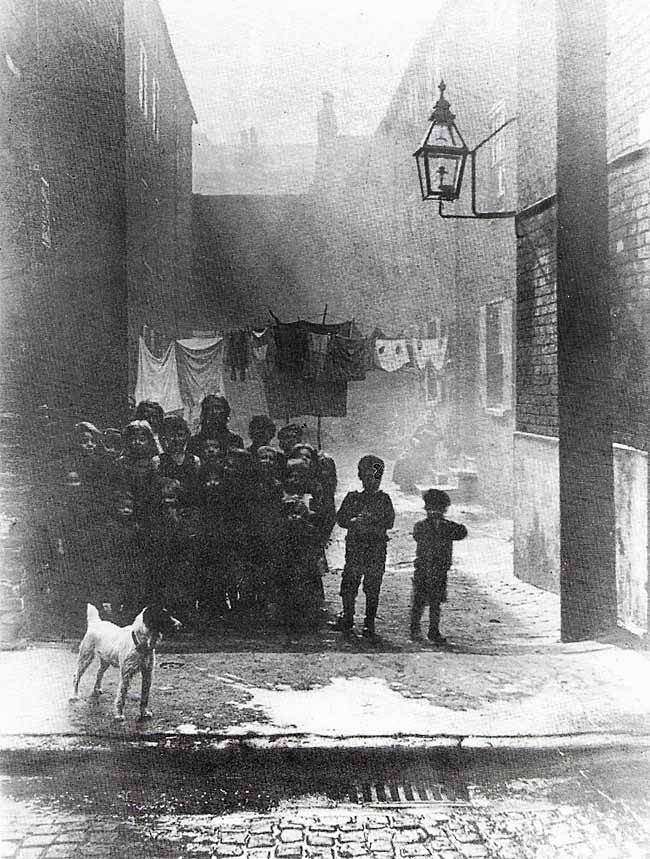< Previous
YESTERYEAR...
 Photograph: courtesy of the Nottinghamshire County Local Studies Library
Photograph: courtesy of the Nottinghamshire County Local Studies LibraryTHANKS TO THE EXEMPLARY PRACTICE of Nottingham Corporation Health Department, we can enjoy this view of children grouped together at the entrance to No Man's Yard, Newington Street, in about 1912. The department made a point of photographing property recommended for early demolition, and a valuable record resulted of many of Nottingham's less prosperous neighbourhoods.
Newington Street was a turning off the west side of Manvers Street - the Trent bus garage just about covers its site today. No Man's Yard ran off Newington Street in a southerly direction, and dated from the years following 1820. It was part of what became known as the Carter Gate/Manvers Street Unhealthy Area. The area came into being during the period (1750-1845) in which Nottingham's population multiplied by five or six times: there was, throughout this time, virtually no extension of the built-up area, because of the common fields surrounding the town. As the Nottingham Daily Guardian put it in its issue of January 1st, 1901, 'Hence arose the abominable practice of economising space by building back-to-back houses for the working-classes.'
By the time of the 1845 Nottingham Inclosure Act, the town had become thoroughly aware of the appalling problems caused by back-to-back housing, in which each dwelling possessed only one outside wall. The Act stipulated, among other things, that no dwelling house should be joined to another on more than two sides, and that every house should be provided with its own attached yard or garden. The Act further required for each house a separate privy (this, unless a water closet, was to be at least fifteen feet from any habitable room), and laid down a minimum provision of three bedrooms above ground floor level in every house.
All this, of course, applied to houses built after the passing of the Act, and No Man's Yard, like its neighbours, fell hopelessly short of these standards. The photograph does not pick them all out, but the yard has seven back-to-back dwellings on either side, built on to similar houses in the adjacent Lewis's Place and Albion Place. At the end of the yard rise houses in Victoria place. When the Unhealthy Area was declared, it was estimated that in the area bounded by Manvers Street, Pennyfoot Street, Carter Gate’ and Southwell Road, there were 343 houses unfit for people to live in: of these only 95 were unoccupied. The 200 worst houses included just ten with an interior water supply. The infant mortality rate here was twice that of the city as a whole, three babies in ten dying before their first birthday. Despite all the problems of this very poor district, the police pronounced it 'remarkably free from crime'. During the First World War many more of the houses became empty, demolition beginning about 1920. Within a few years nothing remained of the old houses and the site has consisted of commercial and transport premises ever since.
The photograph reveals heroic efforts to keep the clothes clean in the face of an unhelpful environment: one of the No Man's Yard housewives sits on a wooden chair at the foot of her steps, while another woman peers out from her front (and only) door. The children are clearly fascinated by the camera - it is doubtful whether anyone had ever photographed this neighbourhood before the authorities began to collect evidence in favour of its destruction. The dog was presumably a happy chance, but the photographer is to be saluted for not shooing it away: whoever he was, he knew how to make a good picture, and arranged the assembled boys and girls very skilfully. Despite all his instructions, the little lad under the gas lamp could not manage to keep still. The date, as already stated, is 1912, so any survivors among the children must now be in their eighties. At the time the photograph was taken, my father, who lived a couple of hundred yards away in Kingston Street, was about nine, so it is possible that some of the boys posing here were his schoolmates.
Stephen Best
< Previous
